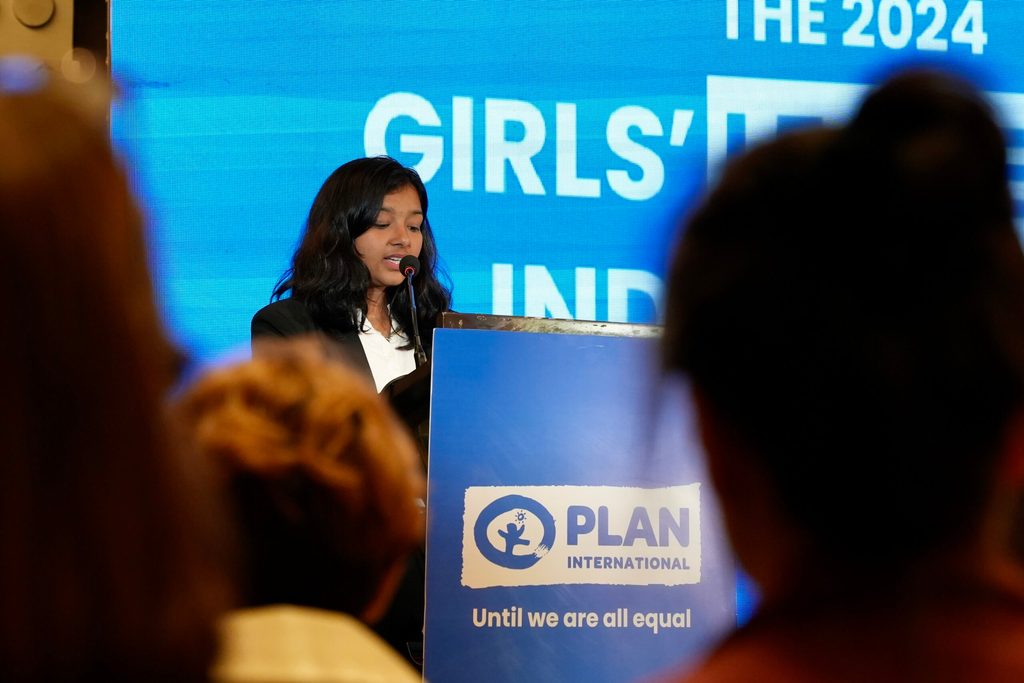Samikshya, 20, is a youth campaigner from Nepal who champions girls’ rights and youth leadership. From childhood poetry to global platforms, her journey and blog show how young people can inspire change. This blog is part of Plan International Nepal’s blogathon for International Youth Day 2025, celebrating youth voices shaping the future.

By Samikshya, youth campaigner
How it all began
For me, change started quietly, with a simple question. When I was in grades 4 and 5, 3 of my classmates stopped coming to school. Later, I learned they had been married off. I wondered why girls in my village had to leave school so early. Why were they forced into marriage while boys stayed in school?
Growing up in Sarlahi, I saw that girls and boys were treated very differently. Boys were sent to private schools, while girls had to go to government schools. People told girls not to speak much. But I refused to stay silent. I wanted to understand and change these unfair rules.
Learning and growing through local actions
I started by taking small steps with my friends. We cleaned our school on environmental day and took part in debates and speeches. These activities helped me find my voice. After finishing my secondary school exams, the COVID-19 pandemic forced schools to close, but it opened up new chances to learn and speak out online.
In 2022, I became the CEO of SDG Studio in Lalitpur as a part of #GirlsTakeover initiative. I realised how few girls and young women have the chance to become CEOs, and how rarely we see them celebrated as role models in such leadership positions. This opened my eyes and widened my vision about what is possible for girls. This platform and the discussions around girls taking over leadership roles showed me that young women can and should lead change. This gave me more confidence to fight against harmful traditions and stereotypes.
As a member of Plan International’s Youth Task Force, I represented young people from Nepal at the Summit of the Future. I thought back to the girl I once was, who had to hide from sunlight during her periods, and now helped create the Girls Pact for the Future. This pact reflects what the Sustainable Development Goals (SDGs) mean to us: the right to speak out, to have justice, and to act.
Speaking up and joining forces
Writing was my first way to speak out. I wrote poems about the shame girls felt during their periods and how they were treated as if they were unclean. Many girls lied about being sick just to avoid school during their periods because schools were not supportive.
As I grew older, I began leading awareness sessions in schools and communities about the SDGs. Joining the Girls Out Loud, a private Facebook group for girls moderated by Plan International Nepal, which now has over 1,800 members, helped me see that these global goals are about our everyday lives.
In 2023, I took part in a youth programme called Youth Action Series: For Our Future. Along with other young people from Nepal, Indonesia, and Australia, I helped write a report about climate justice and education. I was also one of the panellists when the report was launched.
In 2024, I officially joined Plan International’s Youth Task Force. Together with other young activists, I helped write the Girls Pact for the Future, where we shared our key demands for equality and justice.
In 2025, I was honoured to represent Nepali youth at the Asia-Pacific Forum on Sustainable Development. I spoke about many SDGs, shared stories from Nepal, and joined calls for action. When I returned home, I shared what I had learned in youth groups.

“Change starts from the ground up. I am proud to be part of those roots, working for a fairer world where girls have equal chances.”
Samikshya
Challenges and what youth need
Being a young woman, speaking out is not always easy. Sometimes people say I am “too emotional” or “too young.” But I know young people are here to make change. When I felt ignored, I wrote even more. I remembered the girls from my village who told me, “We are with you.”
What we young people really need is simple: support, safe spaces, and leaders who listen. We need to be included in decisions that affect us. We also need to think about all parts of our identity: caste, region, disability, and class, when working for equality. Climate and digital policies should include knowledge from rural and indigenous communities too.
The SDGs promised a fair world by 2030. But are we really listening to those who face the most challenges? Are young people given power, or only asked to be the “voice of tomorrow”?
I want a future where girls do not miss school because of their periods. I want survivors of violence to get justice without proving themselves. I want young people to be leaders now, not later.
For me, youth engagement in local action for the SDGs is not just a project; it is my life. I will keep using my voice through poetry and activism until every girl and young person feels safe, heard, and strong.
Change starts from the ground up. I am proud to be part of those roots, working for a fairer world where girls have equal chances.
Categories: Campaigns


